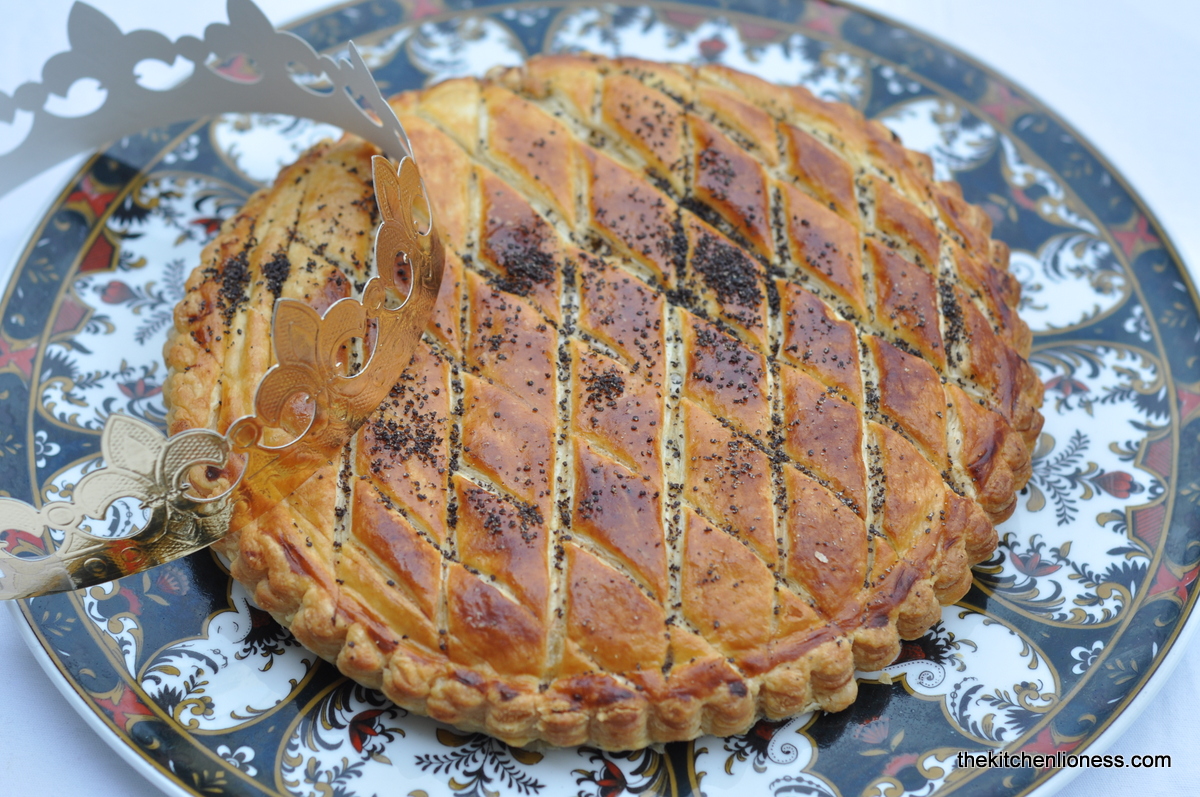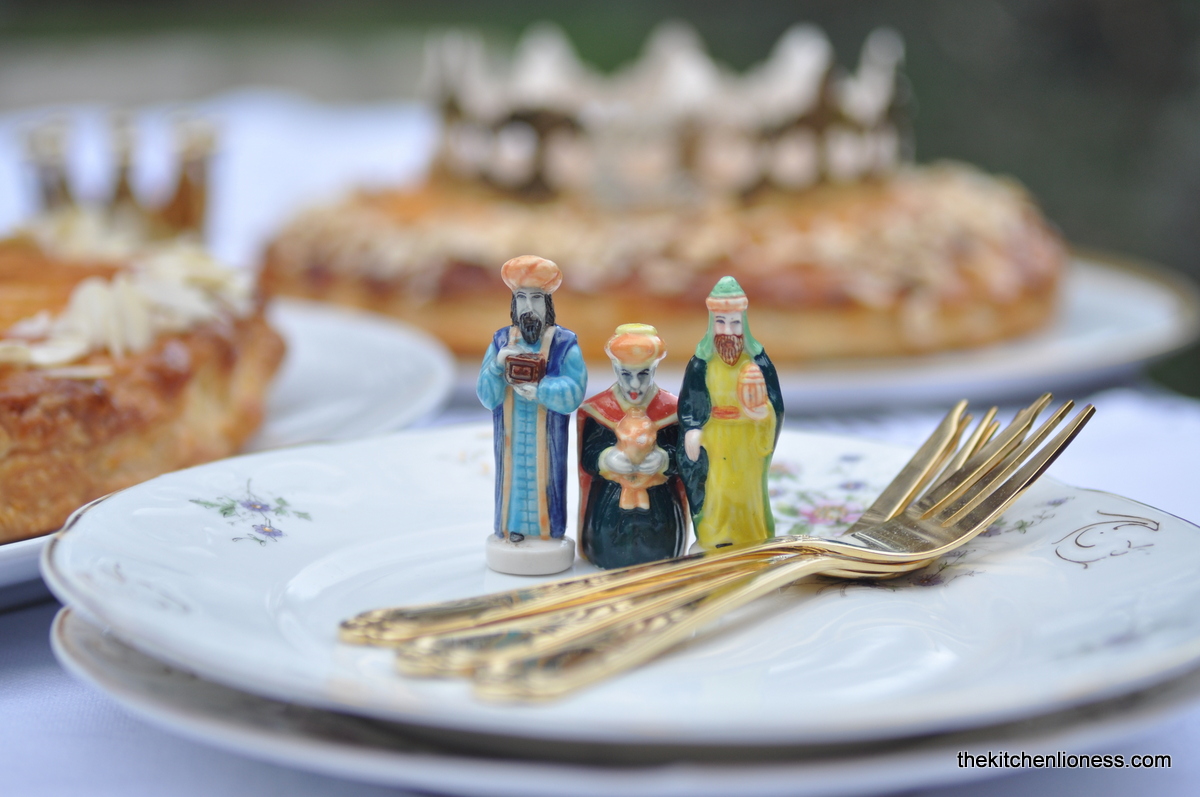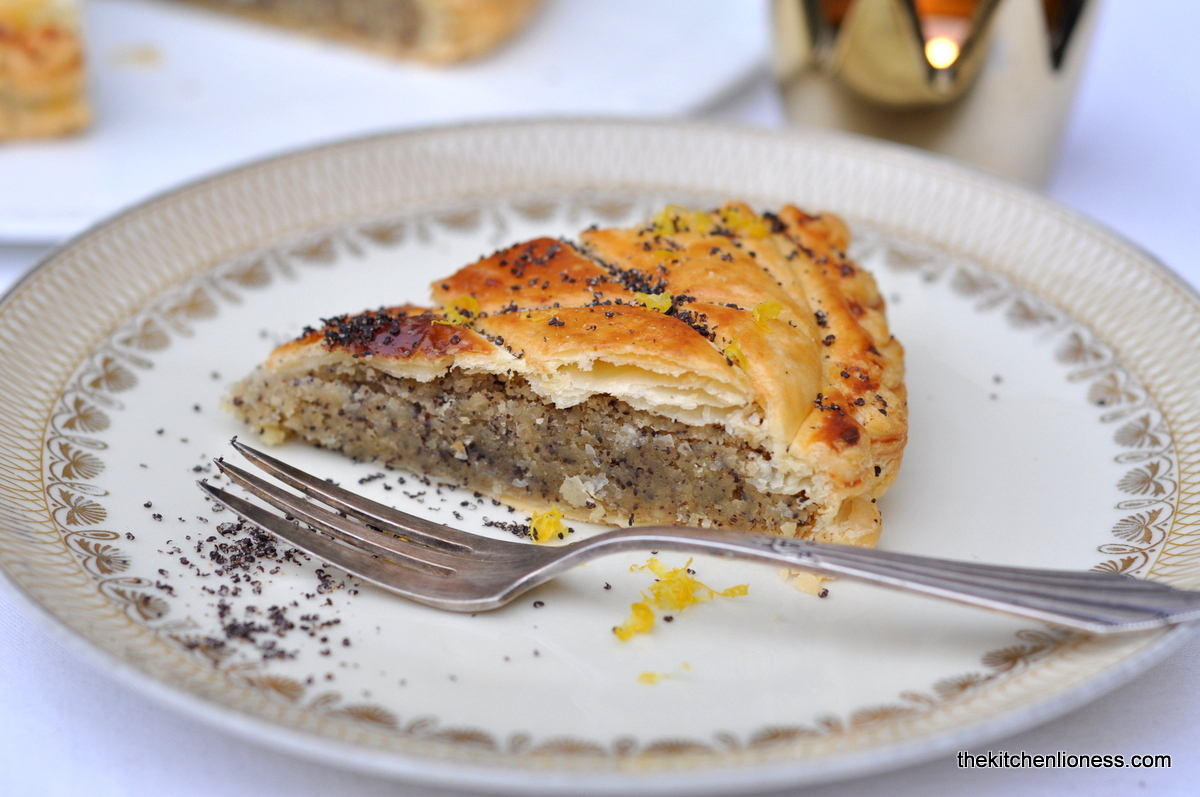The French Galette des rois (King Cake) was created to celebrate Epiphany (January 6th) which marks the arrival of the three Kings or Wisemen, also called the three Magi (Caspar, Melchior and Balthazar) who came bearing gifts (gold, incense and myrrh) for the infant Jesus. Kings is 'les rois', in French, hence the French name 'Galette des rois' for this lovely festive pastry.
In France, there are two kinds of King Cakes - there is the 'Galette des rois' - layers of puff pastry filled with an almond cream, and rather popular in the North of France, then there is the 'Gâteau des rois' a round yeasted cake, much beloved in the South of France and adorned with colorful, sticky candied fruit, resembling a New Orleans King Cake.
If you have ever visited France around Christmas time, you will probably have noticed that the Galette des Rois is baked throughout the month of January. And if you ever had the pleasure to indulge in a slice or two, you will know that a classic Galette des Rois is composed of two circles of puff pastry that sandwich an almond cream, also referred to as frangipane filling.
Each Galette comes with a golden paper crown and always has a trinket, called a fève, or bean, baked into it. If you are lucky enough to get the one slice of cake that has the fève tucked inside the almond filling, you get to wear the crown and be king or queen for the day.
Although the classic Galette des rois basically consits of two components: the buttery puff-pastry circles and the decadent almond filling, homebakers and pastry chefs alike have taken to creating many different fillings including some with fruits (fresh or dried) or fruit compotes (such as apples pears or apricots), chocolate, and various nuts (such as hazelnuts, walnuts and pistachios), but the shape of the Galette remains true to tradition. The edges of the galette are scalloped to show off the rise of the pastry and to seal in the delightful creamy filling that is the perfect counterpoint to the flaky crusts.
Traditionally, Galettes des rois, sometimes also referred to as 'Pithiviers', named for the town in the Loiret (south of Paris) where they are said to have originated from, come with a crown as well as a charm. Some crowns are intricately designed, but most are made of gold cardboard. In earlier times, the charm was a dried bean, a fève, and fève is still the name for the trinket, although today’s fèves, are made of porcelain and can be quite elaborate. The fèves come in all shapes, sizes, and materials. Cartoon characters are popular in France, as are French historical or religious figures. And some bakeries have annual fèves that change. Not only is it fun to see them, but some have become true collectors items. As mentioned above, if the charm is hidden in your portion, you get the crown and the title of king or queen for the day.
If you are a reader of my blog, you will probably remember that in the past I have already blogged about the Galette des rois. In 2016 (here) and in 2015 (here). As our family celebrates Epiphany every year with at least two Galettes des rois, following the traditional recipe, today, I include a variation on the traditional theme, namely a Galette with an almond filling with added lemon and poppy seeds – a combination of flavors that I really enjoy. This is a delicious variation, as the poppy seeds add a nice crunch and the delightful tartness of the lemon cuts through the sweetness of the almond filling. And I love the way the final Galette looks, nice dark golden color and just a sprinkling of poppy seeds on top and maybe a bit of freshly grated lemon zest.
Galette des Rois Citron et Pavot
(Galette des Rois with Lemon and Poppy Seed)
Ingredients
- 500 grams (25x38cm) good quality store-bought all butter puff pastry (OR use homemade puff pastry)
Ingredients for the Filling
- 100g (3.5 ounces) unsalted butter, room temperature
- 100g (3.5 ounces) powdered sugar
- 2 tsps pure vanilla sugar (homemade or store bought)
- a pinch of fine sea salt
- 1 egg (L), organic or free-range
- 125g (4.4 ounces) almond flour
- ¼ tsp ground Ceylon cinnamon
- grated zest of one small organic (or untreated) lemon, plus 1 tsp lemon juice
- 2 tbsp poppy seeds, plus some for sprinkling on the top layer
- some egg wash (egg mixed with a bit of water - for a dark golden finish, I like to mix the egg yolk, no white, with a bit of milk instead)
Optional Addition to the Filling
- fève: small porcelain figurine/whole almond/bean OR coin wrapped tightly in a small piece of aluminium foil
Preparation of the Galette
- Line a baking sheet with parchment paper.
- Roll out the pastry and cut two 26cm (10in) rounds. Chill while preparing the filling.
- Beat the butter, powdered sugar, vanilla sugar and salt until creamy, light and fluffy.
- Add the egg and beat for three minutes.
- Whisk together the ground almond meal and the cinnamon.
- Add the almond mixture to the butter mixture and beat until well combined.
- Now stir in the grated lemon zest, the lemon juice and the poppy seeds.
- Place one of the pastry circles on the prepared baking sheet and brush a 2 cm (0.8in) border of egg wash around the edge of the pastry circle. NOTE: keep the remaining egg wash for brushing the final cake.
- Spoon the frangipane mixture on the pastry circle, spreading it evenly and keeping it inside the egg wash border. NOTE: If you would like to add a figurine, nut, bean or coin (wrapped in foil), do it now by gently pushing it into the filling and then proceed with the recipe.
- Place the second pastry circle on a piece of parchment and use the dull side of a knife to lightly mark lines on top of the pastry (chose a design of your liking, for example diamond shapes, spokes of a wheel or a zig zag pattern).
- Now place the marked pastry on top of the filling.
- Carefully crimp around the edge with your fingertips or use the tines of a fork, making sure that the filling will not leak.
- If you have the time: freeze the Galette for 30 minutes OR place it in the fridge for about 2 hours (that will help with keeping the shape of the Galette).
- Preheat your oven to 180°C (350°F) and take the Galette out of the fridge or freezer.
- Brush with the remaining beaten egg wash. NOTE: try not to get the glaze on the sides of the pastry, as that will inhibit it from rising properly at the edges.
- Use a paring knife to poke 5 holes in the top, to allow steam escape while baking.
- Sprinkle with some poppy seeds.
- Bake for 40 to 45 minutes or until both base and top are crisp and dark golden brown, then remove from the oven and slide the Galette off the baking sheet and onto a cooling rack. NOTE: it is common for the top of the Galette do deflate when cooling, no worries.
Whether you are choosing to make the traditional version (for the classic recipe, please go here) or the lemon poppy seed version of the Galette des Rois, please note that when working with puff pastry, it’s always important to keep it well-chilled and work as quickly as possible as the puff pastry tends to act up as it warms up. And make sure to seal the edges of your Galette really well to avoid the filling leaking out. Frozen puff pastry can often be found in the freezer section of well-stocked supermarkets, chose an all butter puff for best results, if possible.
If you would like to add a fève to your filling, you can find some very pretty new and vintage ones online. The tradition has branched out to include lots of secular as well as religious themes. Whichever fève you chose to include in your Galette(s) des Rois, do make sure to tell your family, friends and/or guests about it before you serve your cake slices.
Hope you will try out the recipe(s) - come January 6th, my family and friends always look forward to some pretty and delicious Galette des Rois, not only is it one last holiday dessert to look forward to before all those New Year resolutions kick in but it is also quite the treat, especially when served with a steaming cup of tea or good strong coffee.
Please note that my recipe for the Galettes des Rois is part of my series for a 'local' (meaning across the state of North Rhine-Westphalia) radio station, where, throughout the years, I talk about different baked goods that are closely tied to various holidays and seasons. If you are interested, have a listen (in German) HERE.
The various recipes of my series can be found here:
- in January, for Three Kings Day (Dreikönigstag) two kinds of Galette des Rois (Dreikönigskuchen) (HERE)
- for Lent (Fastenzeit) Lenten Soup with Lenten Beugel (Fastenbeugel) (HERE)
- for Good Friday (Karfreitag) the delicious Hot Cross Buns (HERE)
- for Pentecost /Whitsun (Pfingsten) the fun Allgäu Bread Birds (Allgäuer Brotvögel) (HERE)
- for the beginning of the summer vacation, the lovely Sacristains (Almond & Sugar Puff Pastry Sticks) (HERE)
- for St Christopher's Day (St Christophorus), the energy-packed Müsli Power Bars (Müsli Energieriegel) (HERE)
- for Mary's Assumption Day (Mariä Himmelfahrt) my Tear & Share Herb Bread (Kräuterbrot) (HERE)
- for Mary’s Birthday (Mariä Geburt) some very pretty Mary’s Sweet Rolls (Süße Marienküchlein) (HERE)
- for Thanksgiving (Erntedankfest) a delicious and seasonal Thanksgiving Apple Tart with Frangipane (Erntedank Apfeltarte mit Mandelcreme) (HERE)
- for Halloween a Pumpkin Spice Bundt Cake (Kürbis-Gewürzkuchen)
- for St Martin's Day (Martinsfest) the cheerful Sweet Dough Men (Weckmänner) (HERE)
- for St Andrew's Day (Andreastag) a classic Petticoat Tails Shortbread (HERE)
- for Christmas Day (Weihnachten) these Traditional German Gingerbread (Elisenlebkuchen) (HERE)
- for New Year's Eve a New Year's Eve Pretzel (Neujahrsbretzel)
- for Candelmas Day (Mariä Lichtmess) some delightful Navettes de Saint Victor (HERE)
- for Carnival Season (Karneval) these lovely Carnival Doughnuts (Karnevals-Krapfen) (HERE)
- for St Patrick's Day a traditional Irish Brown Soda Bread (Irisches Sodabrot)(HERE)
- for St Joseph's Day a long-forgotten but thankfully re-discovered Sweet Cotton Bread (Baumwollbrot)(HERE)
- for Palm Sunday (Palmsonntag) these very pretty Palm Pretzels (Palmbrezel) (HERE)
- for Easter Sunday (Ostersonntag) an Easter Brunch at Home with Tarte Flambée (Flammkuchen) (HERE)
- for the Month of May (Marienmonat Mai) these elegant Visitandines de Nancy (HERE)
- for Pentecost/Whitsun these festive Beignets (Heiliggeistkrapfen) (HERE) - more delicious treats to come very soon.












I have a small collection of fèves but none are as beautifully crafted as yours! I usually make the traditional galette des rois as I love the almond flavor. But your lemon and poppy seed version sounds amazing. In New Orleans tradition, the finder of the fève may get to wear the crown but the big part of finding the fève is that she or he is responsible for hosting 12th night the next year. (Or, throwing a Mandi Gras Party...)
ReplyDeleteDear David, following your kind comment, come next Januaray 6th, I believe I will make a New Orleans King Cake - the tradition that the finder of the fève is responsible for hosting 12th night the following year sounds like fun! Thank you for pointing that out - always love, love your wonderful comments and your fabulous feedback.
DeleteAs far as my small collection of 'fèves' is concerned, let me tell you that it took some considerate effort on my part to get hold of most of them...;)
If you get a chance to bake the 'Galette des Rois Citron et Pavot', please do let me know whether you liked it as much as we do!
Liebe Gruesse nach Tucson!
Andrea
gorgeous cake - can't wait to try this! :-)
ReplyDeleteThank you very much Amy, appreciate your kind comment!
DeleteIf you do get a chance to try this one, please let me know whether you enjoyed the recipe and/or 'be social'(as they say), snap a pic and post it, I would love to see it :) #TheKitchenLioness
Hope you had a wonderful start to the New Year!
Andrea
Oh, to be queen for a day, what a lovely tradition! Around Easter, Armenians have a similar custom of baking a coin into a pastry called Mijink. Slices are divvied and whoever gets the coin enjoys a year of good luck!
ReplyDeleteDear Colette, so many different recips, so little time to bake them all but baking a Galette or other cake with a coin/almond/trinket etc. and to crown a "Queen" or "king" for the day is always fun - and a delicious treat to boot! The Mijink, or Armenian Sweet Bread, that is baked to celebrate the first half of Lent that has passed, sounds like quite a treat too! Will you bake one this year and then blog about it and share your family`s tradition, that would be wonderful!
DeleteHope you and your lovely family are all doing well!
Take care my friend,
Andrea